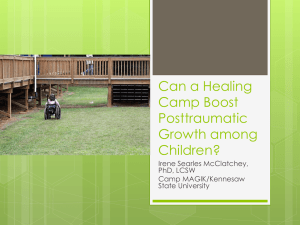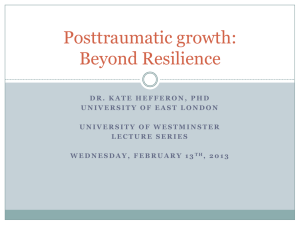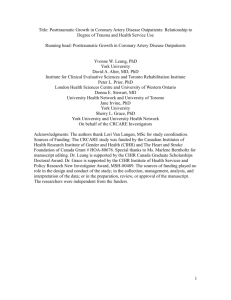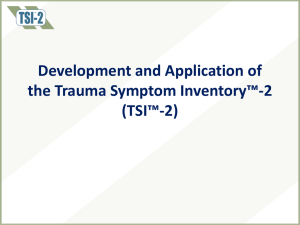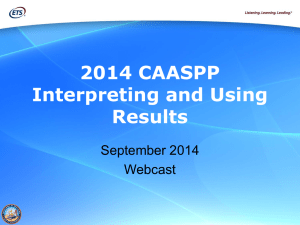ppt - Dr. Kate Hefferon
advertisement
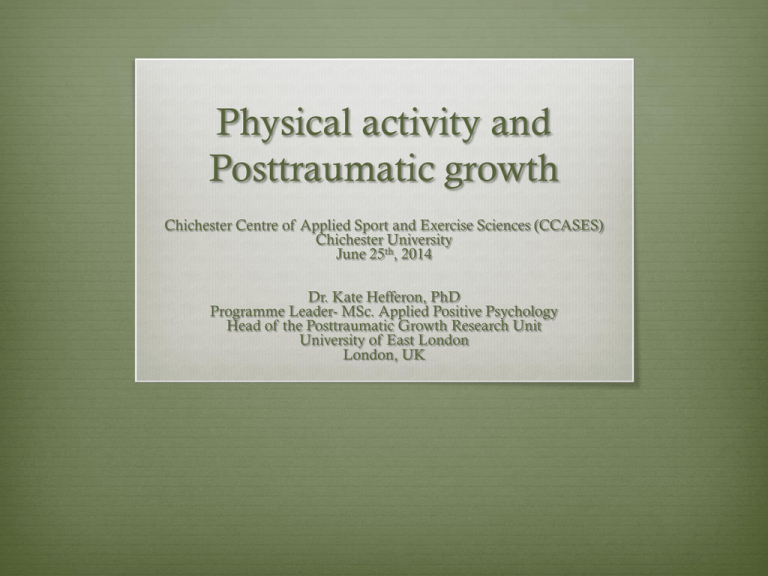
Physical activity and Posttraumatic growth Chichester Centre of Applied Sport and Exercise Sciences (CCASES) Chichester University June 25th, 2014 Dr. Kate Hefferon, PhD Programme Leader- MSc. Applied Positive Psychology Head of the Posttraumatic Growth Research Unit University of East London London, UK Outline Physical activity and well-being Post-traumatic Growth (PTG) Corporeal Posttraumatic Growth Conclusions and questions Physical activity and Wellbeing Physical activity is a ‘stellar’ method of intervening to promote well-being (Hefferon & Mutrie, 2012) Reduces the risk of developing several diseases Produces both hedonic and eudaimonic experiences of well-being including: positive emotions, self esteem, body image, cognitive functioning, psychological well being, posttraumatic growth, flow, purpose in life, etc. Mens sana in corpore sano: Healthy body = healthy mind (Somatopsychic Principle) Build psychological and emotional strength via the building of physical strength (Faulkner, Hefferon & Mutrie, In press) Psychological Resilience “the flexibility in response to changing situational demands, and the ability to bounce back from negative emotional experiences” (Tugade, Fredrickson, & Barrett, 2004b, p. 1169) • Recovery, resistance and reconfiguration (Lepore & Revenson, 2006) Posttraumatic growth (PTG) “It is through this process of struggling with adversity that changes may arise that propels the individual to a higher level of functioning than which existed prior to the event.”(Linley & Joseph, 2004, p. 11) • 40-70% experience some positive benefits from trauma • Focus is not to advocate suffering as a situation worth striving for, but rather to examine the phenomenon in which suffering and grief can co-exist with enlightenment and growth (Linley and Joseph, 2004) 1) Perceived changes in self Becoming stronger More confident New awareness of a possible self authentic self A ‘better self ’ Deeper More open More empathetic More creative More alive More mature More humanitarian More special More humble (Tedeschi & Calhoun, 1995, p. 456). 2) Improved relationships Closer relationships with family and/or friends Neighbours Fellow trauma survivors Strangers Find out who “True friends” are 3) Changing life philosophy/ increased existential awareness Reflection of mortality Meaning and purpose in life Finding reasons/making meaning from the trauma ‘Vulnerability’ and ‘the shortness of time’ ‘Once you worry about whether you are going to die, nothing else seems quite as significant to worry about’ (Kennedy, Tellegen, Kennedy, & Havernick, 1976) 4) Changed priorities How and with whom they decided to spend their day Appearance Nature Monetary goods Health New appreciation of life (calling it a ‘gift’) The ‘here and now’ Simple things Time Change life goals Learn new skills Go back to school 5) Enhanced spiritual beliefs Increased spirituality Return to faith Spiritual practices Praying Attending church Gratitude to God Strengthening of faith Bereavement Importance and existence differs across culture (Tedeschi et al., 2010) Example of growth “And it’s…and I feel my life’s better! I know it sounds crazy (laughs), but I feel the quality of my life is better because (sniffles) I’ve prioritized (sniffles) and I know what matters.” Brenda, Cancer survivor Benefits of PTG Improved Physical Functioning Improved Psychological Functioning Reduced substance misuse Reduced distress, anxiety and depression Improved quality of life Gender Rumination Age Social support Coping styles PTG Time since trauma SES Personality traits Education Trauma severity Physical activity and PTG Physical activity and sport in facilitation and as an outcome of posttraumatic growth Breast cancer patients Spinal cord injury Paralympians Severe and enduring mental health service users Acquired disability Very new research area Predominantly qualitative research Breast cancer patients Exercise intervention during chemotherapy Women attributed much of their process and outcomes of PTG to the experience of participating in the exercise programme during rehabilitation Physical Activity as BOTH a facilitator and an outcome Physical activity: “Savior” during difficult time Healthy distraction Camaraderie and positive support Normalized activity Purpose and structure Safe place Expertise of instructors Active coping Physical activity as an outcome of PTG Reconnection to body Body as a barometer Transference of skills The somatopsychic Principle Responsibility for own health New health behavoiurs 5-year follow up of physical activity intervention 70% of those who serendipitously reported PTG were in the original exercise intervention Suggests “window of opportunity” (teachable moment) (Mutrie et al., 2012; Hefferon, 2012; Hefferon et al., 2013; Murphy et al., in press) Main Theme Subtheme Gone off track Loss of physical self Loss of confident self Endeavour Social re-integration Free to ‘Be’ Class constituents Wayne Evoke power Main Theme Subtheme Praise of class A focused challenge Healthy escape Camaraderie Wayne Superstar status Proxy Efficacy Wayne's gym Path to Metamorphosis Lost and found Somato-psychic principle in practice Heightened awareness of health Paralympians (Kampan, 2013; Kampman and Hefferon, 2014;) Body in facilitating PTG Fundamental route to experiencing (PTG) Platform for recovery Provided camaraderie and achievement Promoted a sense of equality Sport Share practical ideas Base for new identity as an athlete Learn new skills Team as a resource Safe environment Reconnection to the body (Hefferon, Grealy & Mutrie, 2009; 2010) In traumas where the body has been damaged or altered, the body has been found to be: 1) A vital component to the process and outcomes of PTG 2) Integral component to their self identity (influencing PTG facilitation) NEW BODY Fear of new body Systematic decline in functioning Reconnection to body Achievement of PTG Participants discuss visceral experiences not mentioned in current tools They can experience dramatic changes to their body which can make them feel a sense of betrayal by their body (as the transgressor) PTG can be experienced via the renegotiation of this corporeal relationship Preliminary Model of Corporeal Posttraumatic growth (Hefferon, 2013) Assumptive beliefs Person-Pre trauma Taken-for-granted body Body-related traumatic event (illness, injury) The body is used as a facilitator and as an outcome of PTG Corporeal Awareness Fear of New body Sport and Physical activity (Vengeful, loss of control) Systematic decline in functioning (Alienation of body from the self) Reconnection to body New relationship with body Listen to body Non-taken-for granted body Increased awareness of health Health behaviour changes (Exercise and diet, cessation of negative health behaviors) Current Projects Posttraumatic Growth Research Unit (UEL) PTG and acquired disability within Paralympians PTG and acquired disability within leisure sports Passion, peak performance and PTG (Olympic and Paralympic sports) (English Institute of Sport) PTG and Wheelchair Basketball (London) PTG interventions (E-mpower) Corporeal Posttraumatic Growth Scale development Conclusions and Considerations Physical activity can be utlised to increase both physical and psychological well being Posttraumatic growth is the phenomenon of surpassing previous levels of functioning than which existed before a traumatic event occurred Research into Sport, Physical activity and PTG is a rapidly expanding area There is a need for further multi-method evaluations of these links Ultimately, there is a need for a more corporeal approach to PTG following trauma Resources www.katehefferon.com Posttraumatic Growth Research Unithttp://www.uel.ac.uk/psychology/research/PTGunit/ Hefferon, K. (2013). Positive Psychology and the Body: The somatopsychic side to flourishing. London: Open University Press. Joseph, S. (2011). What Doesn't Kill Us Makes Us Stronger: The New Psychology of Posttraumatic Growth. Basic Books. Centre for Trauma, Resilience and Growth (CTRG) Nottingham University http://www.nottinghamshirehealthcare.nhs.uk/our-services/localservices/specialist-services/prescribed-services/trauma/ University of Toronto Faculty of Kinesiology and Physical Education http://physical.utoronto.ca/FacultyAndResearch/Research_Areas.aspx Thank you k.hefferon@uel.ac.uk www.katehefferon.com @katehefferon
